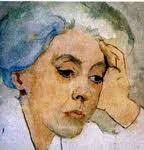 |
| Charlotte Mew, 1869–1928 |
Following
the suggested practice (for the study of a poem) by Phil Roberts in his How Poetry Works (Penguin) I have set
out what seems to me to be the most meaningful pattern of stressed vowels:
putting the unstressed vowels to the left of an artificial line, and using
lower case letters for those line–beginnings which, in prose, would not begin
with a capital letter. There is
no necessarily ‘right’ stress, and therefore no ‘perfect’ reading. Had Mew left
a stressed–marked copy, it would be extremely interesting, but would not
preclude other readings.
⁞ Some said,
because he wuld’n 1 spaik
⁞ any words to women but Yes
and No,
⁞ nor put
out his hand for Parson to shake 2
He ⁞ mun be bird–witted. But I
do go
by the ⁞ lie of the
barley that he did sow, 3
and I ⁞ wish no better thing than to hold
a rake
like ⁞ Dave, in
his time, or to see him mow.
⁞ Put up in churchyard a month
ago,
’A ⁞ bitter
old soul they said, but it wadn’t 4 so.
His ⁞ heart were
in Aaracombe 5 Wood where he’d used to go
to ⁞ sit and talk wi’ his shadder til sun went low, 6
though ⁞
what
it was all about us’ll 7
never know.
And there⁞ baint no mem’ry in the place
of th’ ⁞ old man’s
footmark, nor his face;
⁞ Aaracombe Wood do think more
of a crow —
’Will be ⁞
violets
there in the Spring: in Summer time
the spider’s lace;
and ⁞ come the Fall, 8 the whizzle 9 and
race
of the ⁞ dry, dead leaves when the wind gies chace;
⁞ and on the Eve of Christmas,
fallin snow.
1 The ‘n’ of ‘wuld’n’ acts here as a
‘syllabic’ consonant, and allows the reader to move easily between the
consonants ‘d’ and ‘sp’. (Syllabic l
is the most common consonant to have this characteristic, as in ‘funnel’, ‘gabble’, etc.)
2
The line begins with an outstretched hand and
ends with something of the vigour of a handshake.
3
Expressed in theses measured
single–syllable words there is a wonderful sense of the poet’s aesthetic
delight in the craftsmanship and skill of Dave; and the double–syllable of
‘barley’ gives just the right amount of movement to the remembered action.
4
The poet here adopts the local dialect
to express her divergent view, and this adds immeasurably to the atmosphere and
success of the poem as a whole. She is more intelligent than the country folk,
and yet (in a detached way) thoroughly familiar with the undercurrents of
country life, thought, and ways.
5
The middle vowel of ‘Aaracombe’ is representative of the
weakest vowel in the English language. In linguistics it is called a schwa, and
is represented by an upside down ə.
It is a ‘lazy’ or ‘lax’ vowel, and occurs more than any other in English.
Typically, it occurs at the end of such words as ‘butter’, ‘letter’, ‘painter’, etc. — and, in southern English —
neither the ‘e’ nor the ‘r’ are pronounced (even in formal speech). Other
examples are the second syllables in ‘haemorrhage’,
‘pat–a–cake, etc. It is never
stressed, and is the very devil for EFL learners! Probably it makes very little
impact on poetry readers.
6
If the syllables of the last three
words are left unstressed, then this takes on the pace of the waning of the day
7
Syllabic l again.
8
There is no indication of particular
American influence on the poet, and ‘Fall’ seems to have been chosen because
Autumn would have one too many syllables in it. Spring, summer, and fall are
named, but winter is simply evoked by the last line.
9
This seems to be an onomatopoeic word
made up by the poet.
The rhyme
scheme is very interesting, and seems nowhere ‘forced’ in the interests of
meaning. The orthographical use of dialect is extremely successful.
_____________________
_____________________
The index on Blogger does not work, so I'm creating an index to the blogs according to title, theme, subject. This can be found on my website:
No comments:
Post a Comment